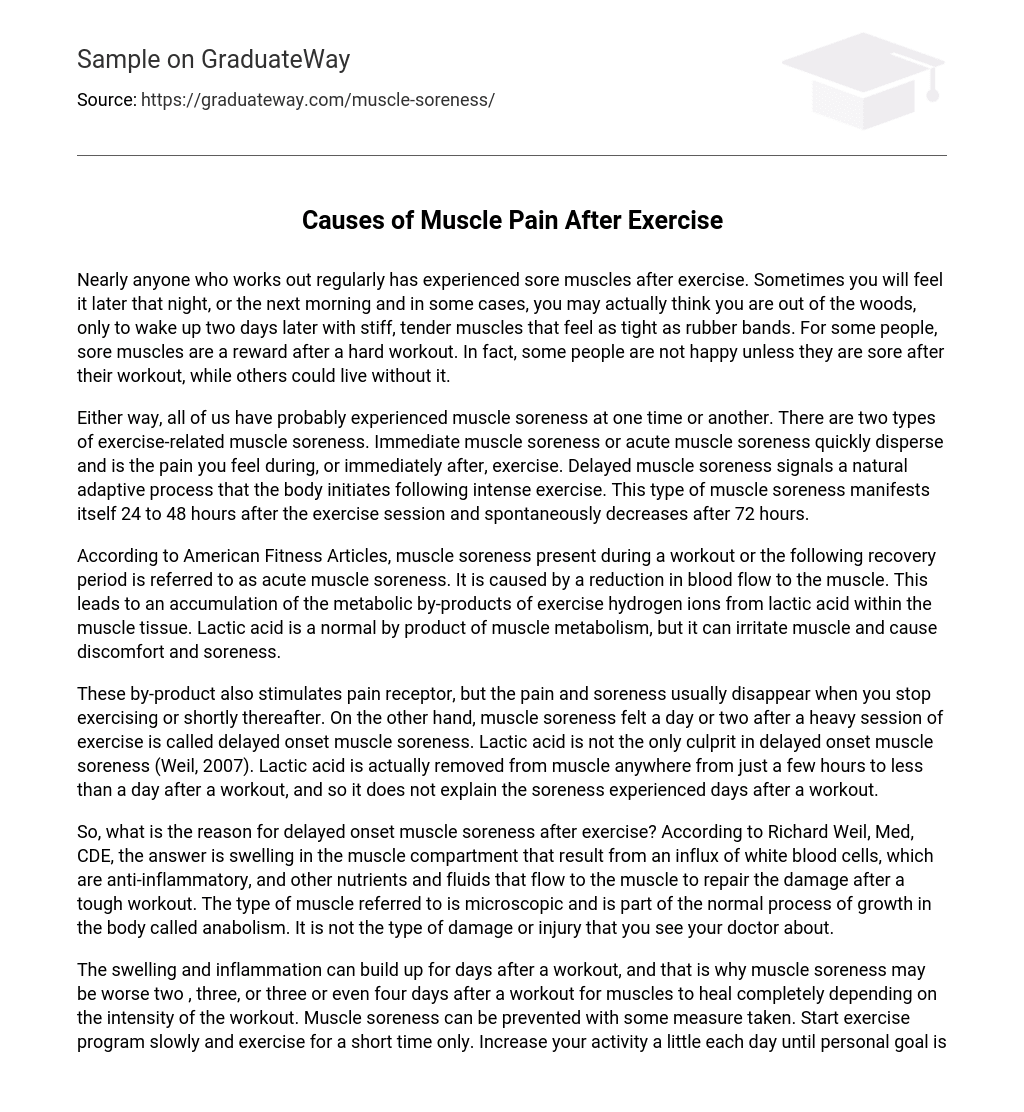Individuals who engage in regular physical activity often encounter muscle soreness following their workout, whether it manifests later in the day, the next morning, or even a few days afterward. While certain individuals perceive experiencing sore muscles as a beneficial outcome of an intense exercise session, others prefer to completely evade it.
Muscle soreness is a common experience that we all have likely encountered regardless of the situation. There are two types of exercise-related muscle soreness: immediate or acute muscle soreness, which quickly goes away and is felt during or immediately after exercising; and delayed muscle soreness, which occurs as a natural adaptive process that the body initiates after intense exercise. This kind of muscle soreness usually emerges 24 to 48 hours post-workout and gradually diminishes within 72 hours.
Acute muscle soreness, known as exercise-induced soreness, commonly happens during workouts or the recovery phase due to decreased blood flow to the muscles. This causes a buildup of exercise-related metabolic by-products like hydrogen ions from lactic acid. While lactic acid is a natural by-product of muscle metabolism, its presence can lead to muscle irritation and consequently cause discomfort and soreness.
These by-products stimulate pain receptors, but the pain and soreness typically subside upon cessation or shortly after exercise. However, a day or two following an intense workout, muscle soreness is known as delayed onset muscle soreness. Although lactic acid does not solely cause delayed onset muscle soreness (Weil, 2007), it is actually expelled from the muscles within hours to less than a day post-exercise. Therefore, it does not explain the discomfort felt days after exercising.
Delayed onset muscle soreness after exercise, according to Richard Weil, Med, CDE, is the result of swelling in the muscle compartment. This swelling occurs as a result of white blood cells with anti-inflammatory properties entering the muscles. In addition, nutrients and fluids also flow to the muscles to assist in their repair following an intense workout. It is important to note that this microscopic muscular damage plays a critical role in anabolism, which is the body’s growth process. It should be highlighted that this type of damage does not require medical intervention.
Muscle soreness can worsen in the days following a workout due to swelling and inflammation. The length of time it takes for muscles to heal depends on how intense the workout was. However, there are ways to prevent muscle soreness. It is advised to start an exercise program gradually and initially limit its duration. Each day, increase activity levels until personal goals are reached. Once delayed muscle soreness is experienced at a certain intensity of exercise, it will not be felt again unless the intensity is increased.
Muscle soreness acts as a stimulus for rapid adaptation, encouraging muscles to adjust to the intensity of a particular workout. In order to induce soreness, it is important to alter the level of intensity. To prevent delayed muscle soreness, gradually elevate both the frequency and duration of exercise while also increasing the intensity. Prioritizing light exercise before engaging in an intense eccentric-exercise session can aid in avoiding soreness.
When starting a new workout or activity, it is important to take things slowly and avoid overexertion, especially if one is not accustomed to it. It is essential for the body to adjust to the physical demands placed on it. Along with gradually increasing exercise intensity, there are other precautionary steps that can be taken, such as getting a post-workout massage. Massages can help alleviate the discomfort caused by delayed muscle soreness by stimulating larger touch and sensation fibers, which in turn reduces signals sent by smaller pain fibers (Muscle Health: Delayed Muscle Soreness).
Massage has the ability to reduce muscle soreness and accelerate the healing process. It achieves this by activating the nerves in the central nervous system, causing the release of endorphins and serotonin. These substances control how the body handles pain and stiffness while also promoting a sense of overall wellness. Consequently, massage facilitates improved mobility and lowers the risk of additional injuries or muscle tension. Ultimately, it is important to rest and allow your muscles sufficient time to recuperate after exercising, adjusting future workout intensity as needed.
It should be noted that muscle soreness following exercise is not always a sign of a successful workout. Therefore, individuals should not be concerned if they do not feel sore after every workout. Many people rely on immediate muscle soreness as confirmation of their progress, but it is not necessarily indicative of a productive workout. The absence of soreness does not mean the workout was ineffective; rather, it simply suggests that the muscles have been challenged in new ways. If soreness occurs consistently after each workout, it may indicate that the muscles require more time to recover.
Work Cited
“Muscle Health: Delayed Muscle Soreness.” Palm Desert Healing Arts Center: Home Page. Web. 10 Apr. 2011. ;http://www.lovinghealinghands.com/7/16/delayed_Muscle_soreness.html;. Richard Weil’s article on muscle soreness is available on MedicineNet.com. Web. 10 Apr. 2011. ;http://www.medicinenet.com/script/main/art.asp?articlekey=78966;.





